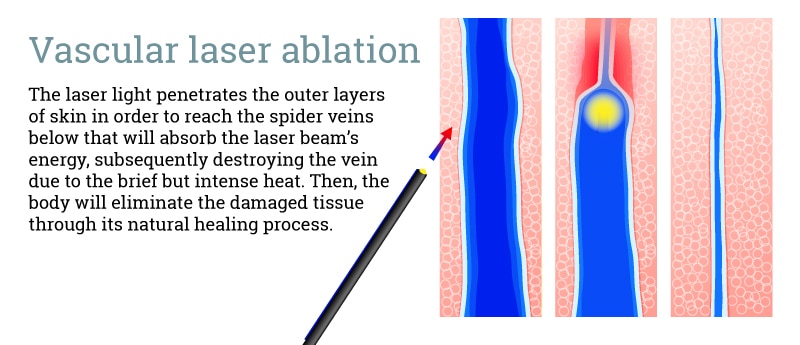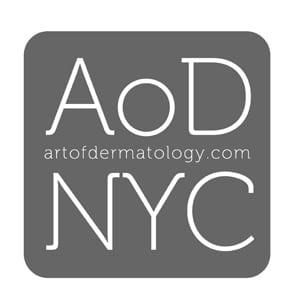Spider veins, or telangiectasias, get their name from the twisting and turning of small red, blue, or purple veins under the surface of the skin which resemble a spider web. Spider veins are a common cosmetic concern for both men and women, affecting up to 50% of the adult population. Even though they can appear on almost any part of the body, spider veins are typically found on the face and legs. A spider vein forms as the result of a weak or damaged valve in a vein that obstructs the flow of blood, thus causing the blood to back up and the vein to swell. (Healthline) Various factors increase the risk of developing spider veins, ranging from genetics to different lifestyle choices. Dr. Luis Navarro, M.D., tells Women’s Health, “Smoking, obesity, and hormonal birth control can all contribute to the formation of spider veins.” In addition to birth control, hormonal changes during pregnancy and menopause can lead to spider veins. Other external factors that cause spider veins include injuries or trauma to the skin and standing or sitting in one place for long periods of time. In some cases the appearance of spider veins is out of your control since genetics can play a role in their development. If your mom or another family member has them, there’s a good chance you could get them, too. While spider veins are a benign condition, they are often seen as unattractive and can negatively affect a person’s self-confidence. If you are bothered by these unsightly veins, continue reading to learn about the available spider vein treatments and which are the most effective.
Treatments for spider veins
A 2012 report published in the Journal of the American Medical Association explains that treatment of spider veins and other venous conditions can range from conservative (medications, compression stockings, lifestyle changes) to minimally invasive (sclerotherapy or endoluminal ablation), invasive (surgical techniques), and hybrid (combination of one or more therapy options). Many websites and blogs suggest DIY remedies that instruct people how they can remove spider veins themselves by applying substances such as apple cider vinegar or witch hazel. However, it’s important to remember that while these suggested at-home treatments to get rid of spider veins may seem easier and cheaper than seeing a professional, they are almost never effective. What you can do at home, though, is help to prevent the future development of spider veins by making healthy lifestyle modifications. These include smoking cessation, weight management, and the use of compression stockings. You may be able to prevent the development of new spider veins by making certain lifestyle modifications, but seeking professional help from a dermatologist is the only surefire way to reduce the appearance of existing spider veins. There are a number of cosmetic treatment options that can help to minimize or even eliminate spider veins, with the two main techniques being sclerotherapy and vascular laser ablation.
Spider Vein Treatment Options
Sclerotherapy

Sclerotherapy is one treatment option for reducing the appearance of spider veins. It is a safe and effective medical procedure that has been used in the treatment of spider veins for over 150 years. Sclerotherapy involves using a fine needle to inject a saline solution directly into the affected veins. The solution causes the spider vein to collapse and shrink, eventually forming scar tissue that the body will naturally dissolve and eliminate. During the weeks following sclerotherapy treatment, the patient will notice the appearance of the spider veins gradually fading away, giving the skin a smoother look and feel. Both men and women can achieve excellent results from this technique, however, the best candidates are those without a medical or family history of blood clotting disorders. This is because after the injection, a small amount of blood that is inside the collapsed spider vein will form a clot before gradually diminishing. The procedure is done without anesthesia and only takes about 20 minutes per session. Most people report feeling mild discomfort, such as a stinging sensation, during the injection. You may require more than one session depending on the size and number of spider veins that are being treated. Once the procedure is complete, you are instructed to wear compression stocking for the first few weeks after the procedure, but otherwise you can return to normal activities.
Who Is a Candidate for Sclerotherapy?
Sclerotherapy can offer excellent results for many women and men who do not have a medical or family history of blood clotting disorders or some other conditions. Prior to treatment, Dr. Krant will provide a thorough physical examination, as well as discuss your medical history with you, to determine if you are a good candidate for this procedure. For pregnant women, Dr. Krant may suggest an alternative spider vein treatment option such as laser treatment.
The Sclerotherapy Procedure
Sclerotherapy is performed by Dr. Krant at her NYC office without anesthesia and is separated into multiple 20-minute sessions for optimal results.
First, the area is thoroughly cleansed and a fine needle containing a special solution is injected into the vein. Most women and men report feeling a mild stinging sensation during the injection process.
After injection, you can expect to return to your normal daily activities, although you will be asked to wear compression stockings for the first few weeks after your procedure. This helps to support the treated blood vessels.
Sclerotherapy Results
Over the next several weeks, you will notice the appearance of your spider veins gradually fading away. Most people see very noticeable results within three to six weeks after sclerotherapy, although more severely affected areas may require additional treatment sessions to maximize your smooth, even results.
Vascular Laser
Dermatologists can also use specialized lasers, such as the Cutera excel™ Laser, to target and eliminate small to medium spider veins.
The laser light penetrates the outer layers of skin in order to reach the spider veins below that will absorb the laser beam’s energy, subsequently destroying the vein due to the brief but intense heat. Then, the body will eliminate the damaged tissue through its natural healing process.
Anesthesia is not required for this procedure, but people do report feeling a slight discomfort during the treatment that has been described as the feeling of a rubber band snapping against the skin combined with a cool, wet spray sensation. The good news is that one session only takes about 15 minutes. Most people will require one to three treatment sessions for optimal results, but this can vary depending on your specific needs and goals.

The Vascular Laser Procedure
During your vascular laser procedure, laser light penetrates the outer layers of skin, reaching the blood vessels below. Targeted blood vessels absorb this light and are effectively destroyed by brief bursts of laser energy. Your body will then remove the damaged tissue through its natural healing process, resulting in a dramatic improvement in the appearance of unsightly spider veins.
Most women and men report that the vascular laser produces two sensations at the same time: the feeling of a snapping rubber band, combined with a cool, wet spray sensation. No anesthesia is required, and the procedure only takes about 15 minutes. Some patients, especially those with rosacea, may experience a mild sunburn sensation, but this is temporary.
While most people require one to three treatment sessions for full results, this can depend on your unique needs. Following your initial consultation with Dr. Krant, you should have an accurate idea of how many sessions may be necessary to meet your goals.
Vascular Laser Recovery
While no anesthesia is generally required, you may experience some swelling, bruising or mild discomfort following your procedure. The size of the area treated will influence the rate at while your body recovers, but in most cases, you can expect to return to your normal daily activities within the next few days, provided you avoid sun exposure until you’ve fully recovered.
During your consultation, Dr. Krant will go over the timeline of recovery that you can expect following your vascular laser procedure.
Vascular Laser Results
Most women and men enjoy long-lasting results that appear virtually immediately following vascular laser treatment, although some swelling, bruising, or redness may still be present for several days. These symptoms, however, should diminish on their own, revealing your even, beautiful skin tone and texture. For maximum results, Dr. Krant may suggest additional laser treatment sessions, depending on the severity of your condition.
There are many safe and effective options offered by dermatologists to get rid of cosmetically concerning spider veins. Besides sclerotherapy and vascular laser ablation, the two most common spider vein treatments, vascular surgery is also an option to remove unsightly spider veins. This treatment is often reserved for very large spider veins and is not a preferred treatment because it is invasive and requires a longer recovery time than the minimally invasive treatments mentioned above. If you’re bothered by the appearance of spider veins anywhere on your body, Dr. Jessica Krant of Art of Dermatology in New York City would be happy to provide a personalized assessment of your needs and goals for treatment. Dr. Krant’s thorough assessment as well as her experience with treating this condition enables her to offer professional insight and advice regarding the most appropriate spider vein treatment options for you.

